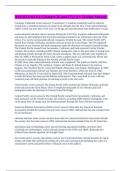APUSH Unit 6.1 (Chapter 16 and 17) || A+ Graded Already.
Cornelius Vanderbilt correct answers "Commodore" Cornelius Vanderbilt used his millions
earned from a steamboat business to merge local railroads into the New York Central Railroad
(1867), which ran from New York City to Chicago and operated more than 4,500 miles of track.
transcontinental railroads correct answers During the Civil War, Congress authorized land grants
and loans for the building of the first transcontinental railroad to tie California to the rest of the
Union. Two newly incorporated railroad companies divided the task. The Union Pacific (UP)
started from Omaha, Nebraska, and built westward across the Great Plains. The UP employed
thousands of war veterans and Irish immigrants under the direction of General Grenville Dodge.
The Central Pacific started from Sacramento, California, and built eastward. Led by Charles
Crocker, the workers, including 6,000 Chinese immigrants, took on the great risks of laying track
and blasting tunnels through the Sierra Nevada mountains. The two railroads came together on
May 10, 1869, at Promontory Point, Utah, where a golden spike was ceremoniously driven into
the rail tie to mark the linking of the Atlantic and the Pacific states.
In 1883, three other transcontinental railroads were completed. The South ern Pacific tied New
Orleans to Los Angeles. The Atchison, Topeka, and Santa Fe linked Kansas City and Los
Angeles. The Northern Pacific connected Duluth, Minnesota, with Seattle, Washington. In 1893,
a fifth transcontinental railroad was finished, the Great Northern, which ran from St. Paul,
Minnesota, to Seat tle. It was built by James Hill. The transcontinental railroads may have helped
to settle the West, but many proved failures as businesses. They were built in areas with few
customers and with little promise of returning a profit in the near term.
Union Pacific correct answers The Union Pacific (UP) started from Omaha, Nebraska, and built
westward across the Great Plains. The UP employed thousands of war veterans and Irish
immigrants under the direction of General Grenville Dodge.
Central Pacific correct answers The Central Pacific started from Sacramento, California, and
built eastward. Led by Charles Crocker, the workers, including 6,000 Chinese immigrants, took
on the great risks of laying track and blasting tunnels through the Sierra Nevada mountains.
American Railroad Association (ARA) correct answers Soon after the American Railroad
Association divided the country into four time zones in 1883, railroad time became standard time
for all Americans.
railroads and time zones correct answers Soon after the American Railroad Association divided
the country into four time zones in 1883, railroad time became standard time for all Americans.
speculation and overbuilding correct answers During speculative bubbles, investors often
overbuild new technologies, as did railroads owners in the 1870s and 1880s. Railroads also
suffered from misman agement and outright fraud.
Jay Gould correct answers Speculators such as Jay Gould entered the railroad business for quick
profits and made their millions by selling off assets and watering stock (inflating the value of a
corporation's assets and profits before selling its stock to the public).
, rebates and pools correct answers In a ruthless scramble to survive, railroads competed by
offering rebates (discounts) and kickbacks to favored shippers while charging exorbitant freight
rates to smaller customers such as farmers. They also attempted to increase profits by forming
pools, in which competing companies agreed secretly and informally to fix rates and share
traffic.
bankruptcy of railroads correct answers A financial panic in 1893 forced a quarter of all railroads
into bankruptcy. J. Pierpont Morgan and other bankers quickly moved in to take control of the
bankrupt railroads and consolidate them. With competition eliminated, they could stabilize rates
and reduce debts.
Panic of 1893 correct answers A financial panic in 1893 forced a quarter of all railroads into
bankruptcy.
causes of industrial growth correct answers - The country was a treasure-house of raw materials
essential to industrialization: coal, iron ore, copper, lead, timber, and oil.
- An abundant labor supply that was, between 1865 and 1900, supplemented yearly by the arrival
of hundreds of thousands of immigrants.
- A growing population and an advanced transportation network made the United States the
largest market in the world for industrial goods.
- Capital was plentiful, as Europeans with surplus wealth joined well-to-do Americans in
investing in the economic expansion.
- The development of labor-saving technologies and an efficient patent system increased
productivity. The federal government granted more than 440,000 new patents from 1860 to 1890.
- Businesses benefited from friendly government policies that protected private property,
subsidized railroads with land grants and loans, sup ported U.S. manufacturers with protective
tariffs, refrained from regulating business operations, and limited taxes on corporate profits.
- Talented entrepreneurs emerged during this era who were able to build and manage vast
industrial and commercial enterprises.
Andrew Carnegie correct answers Leadership of the fast-growing steel industry passed to a
shrewd business genius, Andrew Carnegie. Born in 1835 in Scotland, Carn egie immigrated to
the United States and worked his way up from poverty to become the superintendent of a
Pennsylvania railroad. In the 1870s, he started manufacturing steel in Pittsburgh and soon
outdistanced his competitors by a combination of salesmanship and the use of the latest
technology. Carne gie employed a business strategy known as vertical integration, by which a
company would control every stage of the industrial process, from mining the raw materials to
transporting the finished product. By 1900, Carnegie Steel employed 20,000 workers and
produced more steel than all the mills in Britain.
vertical integration correct answers Carnegie employed a business strategy known as vertical
integration, by which a company would control every stage of the industrial process, from
mining the raw materials to transporting the finished product.




